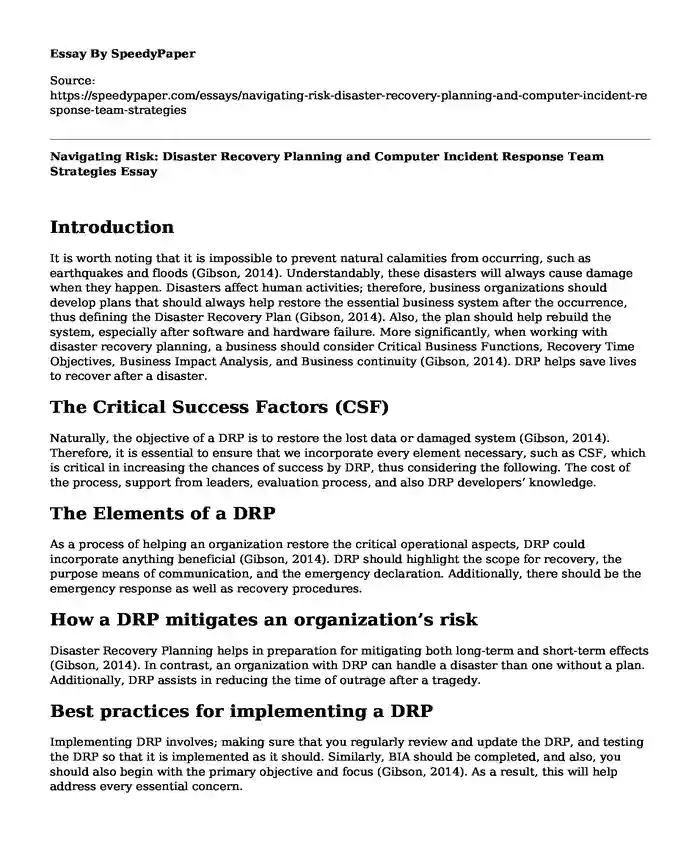
| Type of paper: | Essay |
| Categories: | Risk Business Computer science Disaster |
| Pages: | 3 |
| Wordcount: | 593 words |
Introduction
It is worth noting that it is impossible to prevent natural calamities from occurring, such as earthquakes and floods (Gibson, 2014). Understandably, these disasters will always cause damage when they happen. Disasters affect human activities; therefore, business organizations should develop plans that should always help restore the essential business system after the occurrence, thus defining the Disaster Recovery Plan (Gibson, 2014). Also, the plan should help rebuild the system, especially after software and hardware failure. More significantly, when working with disaster recovery planning, a business should consider Critical Business Functions, Recovery Time Objectives, Business Impact Analysis, and Business continuity (Gibson, 2014). DRP helps save lives to recover after a disaster.
The Critical Success Factors (CSF)
Naturally, the objective of a DRP is to restore the lost data or damaged system (Gibson, 2014). Therefore, it is essential to ensure that we incorporate every element necessary, such as CSF, which is critical in increasing the chances of success by DRP, thus considering the following. The cost of the process, support from leaders, evaluation process, and also DRP developers’ knowledge.
The Elements of a DRP
As a process of helping an organization restore the critical operational aspects, DRP could incorporate anything beneficial (Gibson, 2014). DRP should highlight the scope for recovery, the purpose means of communication, and the emergency declaration. Additionally, there should be the emergency response as well as recovery procedures.
How a DRP mitigates an organization’s risk
Disaster Recovery Planning helps in preparation for mitigating both long-term and short-term effects (Gibson, 2014). In contrast, an organization with DRP can handle a disaster than one without a plan. Additionally, DRP assists in reducing the time of outrage after a tragedy.
Best practices for implementing a DRP
Implementing DRP involves; making sure that you regularly review and update the DRP, and testing the DRP so that it is implemented as it should. Similarly, BIA should be completed, and also, you should also begin with the primary objective and focus (Gibson, 2014). As a result, this will help address every essential concern.
Mitigating Risk with a Computer Incident Response Team Plan
Computer Incident Response Team (CIRT) Plan
A computer Incident is an abuse of security policy that involves activities affecting the system (Gibson, 2014). More precisely, they can cause losses of business integrity, confidentiality, and accessibility. Computer Incident Response Team is a group of experts trained to reduce the damages in an organization. Therefore, the purpose of CIRT is to plan on handling multiple components, inappropriate usage, malicious code, Denial of Service (DoS) attacks, and unauthorized access for an organization (Gibson, 2014).
The elements of a CIRT plan are
The CIRT should be able to outline the policy information. Moreover, communication means and membership information (Gibson, 2014). Additionally, there should be an exact incident response procedure. However, the actors are not limited, as long as they are essential.
How a CIRT plan can mitigate an organization’s risk
Notably, CIRT helps a business get ready to respond faster to incidents. However, the risk should be identified first. Similarly, the organization should identify the CIRT members who are well-equipped with the skills and knowledge needed. Conclusively, it enables every individual to know what role and task to play during emergencies.
The Best practices for implementing a CIRT plan
The organization should train the CIRT members on how to respond and handle the situation (Gibson, 2014). Impose rules guiding CIRT members' operations and include a checklist. Equally important, the business should subscribe to security alerts and outline the security incidents.
References
Gibson, D. (2014, July). Managing Risk in Information Systems. Jones and Bartlett Learning. 2nd Edition. 9781284055955
Cite this page
Navigating Risk: Disaster Recovery Planning and Computer Incident Response Team Strategies. (2024, Jan 23). Retrieved from https://speedypaper.net/essays/navigating-risk-disaster-recovery-planning-and-computer-incident-response-team-strategies
Request Removal
If you are the original author of this essay and no longer wish to have it published on the SpeedyPaper website, please click below to request its removal:
- Leader Definition Essay Examples
- Essay Sample: Mini-Management Plan for Cyber Software
- Free Essay Sample: Weaknesses and Threats of Southwest Airline
- Mind Change - Book Review Essay Example
- Pets Essay: Crafting an Inspiring and Catchy Paper Everyone Will Love
- Free Essay: Business Law Report
- AI Regulation, Cybersecurity, Superintelligence: Issues with AI Dev - Essay Sample
Popular categories




